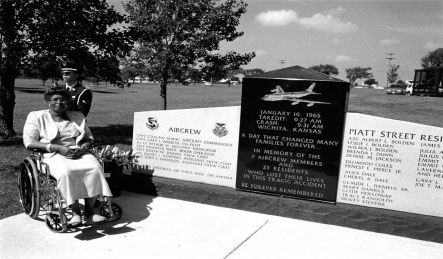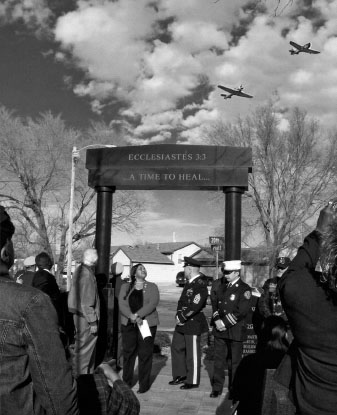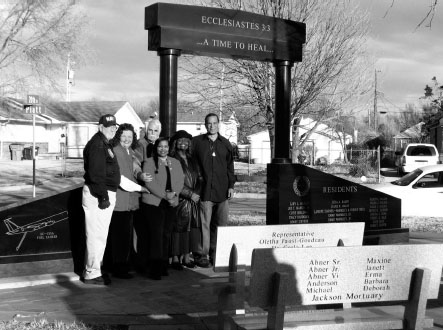Mayday Over Wichita (20 page)
Read Mayday Over Wichita Online
Authors: D. W. Carter

T
HE
F
IRST
M
EMORIAL
Thirty-six years passed before the first collective memorial service took place. The service was held at the McConnell Base Chapel on June 9, 2001. The relatives of Capt. Gary J. Widseth (copilot), 2
nd
Lt. Arthur Sullivan (navigator) and several others helped establish a stone marker and organize a memorial service to honor the memories of those lost. While bagpipes bellowed “Amazing Grace,” the victims' family members and airmen in attendance carried stargazer lilies, each representing a victim, down the aisle in an orderly fashion. It was a truly touching service, and there was scarcely a dry eye visible. Mrs. Widseth described the service as “beautiful” and “orderly”âas only a military service could be.
408

A McConnell Senior Airman lays a flower during the memorial service and monument dedication ceremony held in June 2001.
22
nd
ARW History Office
.

Erna Starnes-Winter lost members of her family in the 1965 crash. She is seen here with the memorial monument commemorating crash victims at its dedication ceremony.
22
nd
ARW History Office
.
It was long overdue in the eyes of many in attendance, but it finally marked the beginnings of acknowledgement and a bit of closure. On that day, the McConnell officials promised, “no one would be denied entrance to see the monument dedicated to the crew and civilians.”
409
But that was a promise they could not keep.
A N
EW
M
EMORIAL
With the worst act of terrorism our nation has ever seen on U.S. soil occurring just three months later, on September 11, public access to the memorial via McConnell was limited. The relaxed security and open gates the public once enjoyed on military installations throughout the country vanished. Thus, a complaint in the years following the McConnell memorial was that its location was not readily accessible. Once again, it seemed the memory of those lost on Piatt Street would soon fade from public view under the shadows of larger events affecting the nation.
John Polson searched for a way to stop history from repeating itself. Polson, a white male in his sixties with no connection to the victims, was an unlikely candidate to generate interest in a disaster affecting Wichita's black community. Nevertheless, Polson was a lifetime resident of Wichita and a community activist who was always troubled by the fact that there was no memorial on Piatt Street to honor the victims. According to Polson, “In the middle part of 2005, things got going on the memorial.”
410
He approached Oletha Faust-Goudeau, now a Kansas senator, in 2004 and made recommendations to erect a memorial at the location of the crash site. As Polson lamented, “No memorial and public recognition had taken place,” and something needed to be done. For Polson, the realities of what had happened back in 1965 and how much worse it could have been still bothered him. “When that plane went down, if it had been three hours later and two to three miles due east,” he remembered, “it would have struck the Field House killing ten thousand people.”
411
The Field House, which opened a decade prior to the crash on December 3, 1955, was a large, circular sports arena located on the campus of WSU. Polson, a senior in high school during 1965, had plans to attend a basketball game there that afternoon. The WSU Shockers were playing against St. Louis University, and fortunately for the university and Wichita itself, a greater disaster did not occur. Just a few hours after the crashâwith jet fuel still dripping from the roof of the arena and weary firemen soaking the wreckage of Raggy 42 only blocks awayâthe WSU Shockers won the Missouri Valley outright for the first time in history. They didn't cancel the game.
T
HE
WSU T
RAGEDY
Polson cited several reasons why he felt the Piatt Street memorial had remained stagnant for so long. Among these were race, the social climate of the 1960s and the relatively small city of Wichita at the time. But he also recounted confusion over the years concerning another great tragedy involving yet another plane crash and the Wichita community. On October 2, 1970, on their way to a football game with Utah State University in Logan, Utah, several members of the WSU football team were killed when their plane collided with a mountain just outside Silver Plume, Colorado.
412
Of the forty people on board, only eight survived. A memorial fund was established for the WSU plane crash the day after the accident. Two weeks later, there was over $11,000 in donations to build a memorial. One year later, a memorial was erected on the WSU campus, and an annual ceremony has been held there ever since.
413
Years after the WSU plane crash, many in the community muddled it with the Piatt Street crash of five years earlier due to the relatively close time frame of each occurrence. Even in 2013, a young airman stationed at McConnell, who grew up on Piatt Street, remembered being told by his grandfather that it was the WSU football team that had crashed on Piatt. Only years later did he discover that the Piatt tragedy involved a plane he now knows intimately as a new KC-135 crew chief.
414
In truth, many Wichitans today
still
confuse the WSU plane crash with the Piatt Street plane crash. Therefore, as Polson and countless others knew, establishing a memorial could respectfully distinguish the memories of those lost in both catastrophes.
R
EFLECTION AT
L
AST
It was not that Polson's recommendation was somehow new or revolutionary. Clearly, there had been grumblings in the Wichita community for decades regarding the lack of a memorial at the crash site. But in 2004, the right people in the right places at the right time were assembled to put forth the energy and effort. A committee composed of various members of the Wichita community, city council, military and local businesses worked tirelessly to generate revenue for the memorial. Much work was required. Hundreds of letters were sent out for donations, fundraisers were established, grants were sought after and grass-roots campaigning continued for nearly two years to gather the funds needed to erect a memorial.
415

Planes soar above Piatt Street memorial.
Richard Harris, Kansas Aviation Centennial
.
At last, six years after the first memorial service at McConnell and at a cost of well over $100,000, a large granite memorial was raised just south of 20
th
and Piatt Street. It was called a “venture of public and private work.”
416
The tenacity and generosity of all involved was finally on display.
The memorial stands approximately thirty feet from the intersection that was the point of impact and rests on the west side of the street, where, nearly half a century earlier, homes were consumed by fiery jet fuel. Leading visitors to the massive memorial are 1,171 bricks, purchased by individual donors from the community.
417
Twenty-two feet in length at its base and equipped with reflection benches and a donor-engraved brick plaza, the towering memorial is crowned with a fifteen-foot-high archway inscribed with the scripture “â¦A Time To Heal⦔ Located at 2037 North Piatt on 1.45 acres of park grounds set aside in 1971, the lofty granite and brick structure serves as a testament to those who perished.
418
The base of the memorial contains the names of all the victims, both military and civilian. At its unveiling in July 2007, it seemed that closure might take place at last. Thirty lives, taken much too soon, are yet remembered, and the dreadful silenceâlasting nearly half a centuryâhas at least been broken. Let it never return.

Several members of the Piatt Street memorial committee stand together on January 16, 2012.
From left to right
: Colonel Herb Duncan with the Commemorative AirForce-JayHawk Wing, Dr. Carla Lee, Mr. John Polson, Kansas Senator Oletha Faust-Goudeau, Ms. Sonya M. House and Darryl Woodard.
Richard Harris, Kansas Aviation Centennial
.
EPILOGUE
History will have to record that the greatest tragedy of this period of social transition was not the vitriolic words and the violent actions of the bad people, but the appalling silence and indifference of the good people
.
âDr. Martin Luther King Jr., January 27, 1965
419
Giants roamed the earth in 1965. Their immense girth, strength and influence pressed heavily upon the masses, and their thundering voices swallowed up headlines for an entire decade. They went by the names of Kennedy, King, Johnson, Chavez, Hoffa and McNamara. They cleared paths, making resonating waves in many areasâpolitics, civil rights, domestic programs, workers' rights, labor unions and Vietnam. These giants, it seemed, were invincible, and their weighty, panoptic shadows cast on American society like a thick blanket.
In the midst of these heavyweights, beneath their towering stature, was the burgeoning city in Kansas named Wichita, which was experiencing its own social upheaval and turmoil as race relations worsened in 1965. And at sixteen days, nine hours and thirty-one minutes into the New Year, disaster struck. Yet, in such a tumultuous, volatile and protean time, the Piatt Street tragedy was but a ripple.
Four days after the crash, President Lyndon B. Johnson was inaugurated, beginning his quest to achieve the Great Society. Four days after that, suffering from a stroke, Winston Churchill passed away in England, and a month later, Malcolm X was gunned down in New York City. In 1965, black churches burned in the South; murders were rampant in Mississippi; the Vietnam War escalated; race riots broke out in Watts, California; thousands marched in Selma, Alabama; thousands more protested the Vietnam War; and thousands stood up or sat down for equality. No shorter span of time so greatly influenced the course of social America as did the 1960s.
Meanwhile, as publicity waned and the '60s grew louder and increasingly violent, the roar over the Piatt Street crash was reduced to a small chatter. Then, with the 1970s bringing its own grief involving plane crashesâthe WSU plane crash in October, the Marshall University plane crash in November and another KC-135 crash in Wichita four years later, on March 5, 1974âPiatt Street faded from view.
